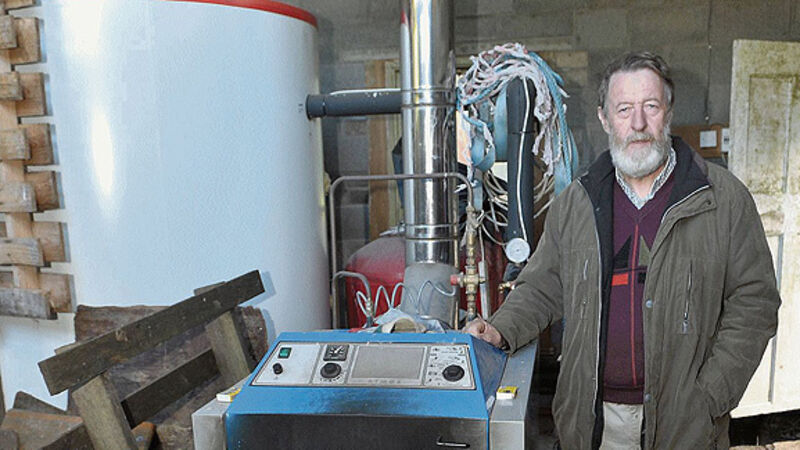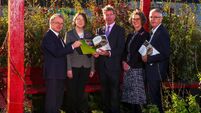Wood future bright as groups seeks to expand services

“I have a wood gasification stove myself for the farmhouse, which replaced the oil burner,”says Michael.
“In an open fire, 85% of energy goes up the chimney, it’s 25% in a wood burner, but in a gasification stove, only 5% to 10% is wasted. We just put timber in once or twice a day, then it’s done.”
That’s good example from the chairman of a group which has as its main objective to maximise returns to forest owners through good forest management.
Limerick and Tipperary Woodland Owners hopes to become a big player in biomass in the mid-west, It was formed as a producer group for private forest owners in Oct 2010 (biomass refers here to plants or plant-derived materials which can be used as a renewable energy source).
Michael Ryan emphasises the importance of both Teagasc and the local IFA in kick-starting the initiative — indeed, Michael is the IFA forestry sector representative in the region.
“In Oct 2010, the IFA and Teagasc called meetings of forest owners, to try to promote the formation of producer groups. Our group was formed, and at the time, the main aim was to create awareness of forest management practices amongst members. Most members are small-scale forestry owners, with an average of eight hectares. So there was no economy of scale possible for individuals. Users like continuity of supply, and groups of woodland owners can give that. Also, a contractor is more likely to work for two or three farmers together than one on his or her own”.
Now, the group is expanding into provision of member services, including selling woodchip on behalf of members and a recent supply contract was established with Danone’s Rocklands, Co Wexford plant.
“A lot of timber is coming on stream now, due to plantings in the early 1990s, says Michael. ” Some of this goes into pallet board and stake wood, while a big percentage goes into pulp. From this, the end uses include chip board and MDF board, as well as firewood in the form of logs or chippings for CHP biomass boilers.”
Membership of the group varies, based on the production cycle forest owners are at. At present, there are about 70 members in ten clusters of woodland owners in Tipperary and Limerick.
Distance is important in making biomass efficient. It is generally recommended to have distances of less than 50km distance between source and burner. Timber for firewood needs 6-12 months to lower the moisture content, so there is a cash flow lag.
Michael Ryan talks money: “Standing trees are worth about €15 a tonne. You can employ a contractor to cut and place them onto the roadside. There, you can sell by the grade. At first thinning stage, pallet board is the best earner, from the wide bottom of the tree. It’s worth €47, €48 a tonne. The middle of the tree goes into stakes, the tops for pulp. Pulp is worth €27-30, but it can cost up to €24 to get it out onto the road. Hence the need for a producer group, to gain economies of scale and to limit the use of expensive middlemen.”
For this and other reasons, the time is right for the Limerick and Tipperary Woodland Owners to start to look further afield, and further down the chain, to start to try to supply processed product to some of the organisations and businesses using biomass boilers.
“At present, we’re establishing an inventory to see what’s in both counties and who can do what, in terms of processing.”
From households with wood stoves or gasification, to sustainable industries, farmers, and local authorities, north Tipperary is leading the turn to biomass.
Locally, biomass is fuel, most often willow or miscanthus, grown for use in specialised boilers. Part of the drive towards biomass, and other renewables, comes from the hard work of the Tipperary Energy Agency (TEA).
Since 1998, TEA has worked at both ends of the renewable energy spectrum — efficiency and production — and has helped interested parties with all the stages in between, including planning, feasibility, instillation and learning.
Michael Bell of TEA described some of their work.
“Our aim is to reduce carbon dioxide emissions in Tipperary, especially through sustainable energy. We provide energy management to the county councils, colleges and others. The councils are the largest energy consumers in Tipperary.”
TEA were central to the SERVE project (Sustainable Energy for the Rural Village Environment), which financially supported a number of Tipperary-based organisations, business and householders to move towards use of renewables and also energy efficiency.
The SERVE project supported the installation of 2MW (Mega Watts) of commercial wood chip boilers plus a further 2.3MW of domestic wood log stoves in the region. This is enough for 400 households to benefit from the latter, while local farmers who supply the wood also benefit.
The beauty of this system for local economies is that the shorter the distance, the more efficiently it works — because of the money needed for transport costs.
Some of the bigger boilers installed include a 600kW system at Gurteen Agricultural College, a 400kW system in Nenagh swimming pool, and a 1MW double boiler in the Ecovillage, Cloughjordan.
“We use 200-300 tonnes per year,” Dr Duncan Martin of Cloughjordan Ecovillage says. “The wood is virgin timber, all Irish-grown soft-wood, either sawmill waste or forestry thinnings, depending on the supplier. Moisture content has to be under 30%.”
North of Cloughjordan, Gurteen Agricultural College has not only installed a biomass district heat system, they are in the process of supplying it with dried willow chip. The source? Their own 32 hectares of willow, grown just 700 metres from the boiler itself.
Indeed, the willow also dries itself, as it provides the heat to reduce moisture content in a dedicated room, where off-peak drying occurs. Peat fuel was costing Gurteen €50,000-€60,000 for heating. Now heating costs have halved, and carbon dioxide savings are about 700 tonnes per annum.
Building on the SERVE project, another pan-European initiative called the FOREST project (Fostering Efficient Long Term Supply Partnerships) has been working directly with businesses from all sectors of the wood energy supply chain. This includes forest owners, harvesting contractors, wood chip producers, boiler installers, operators, manufacturers and owners in the mid-west









